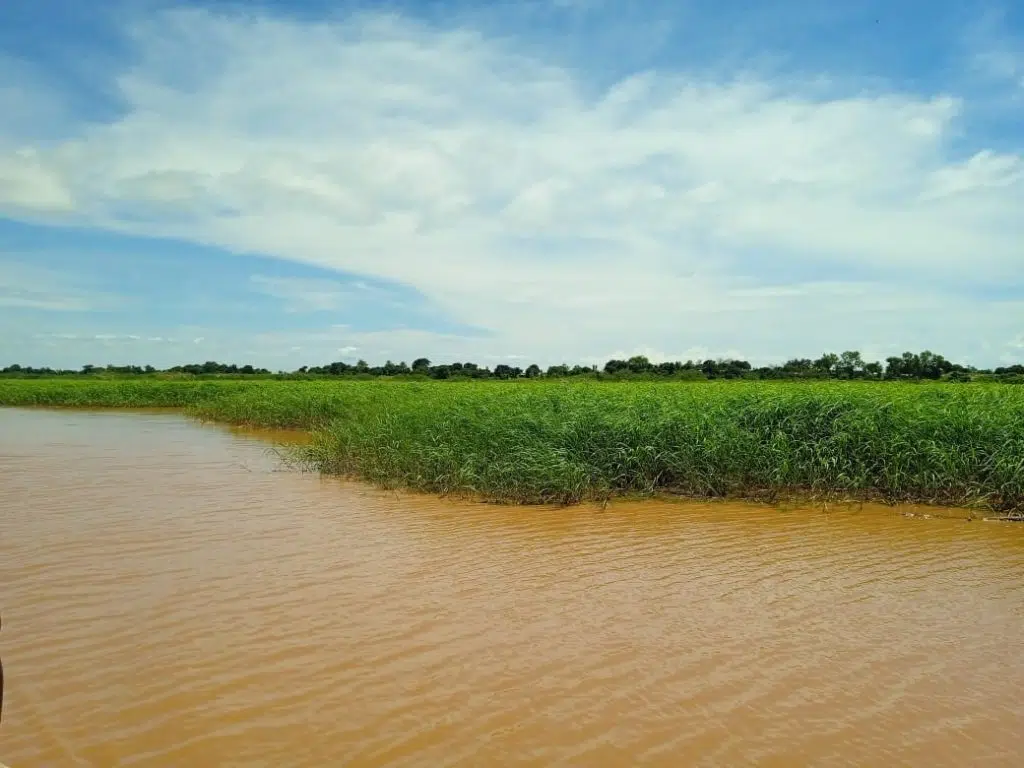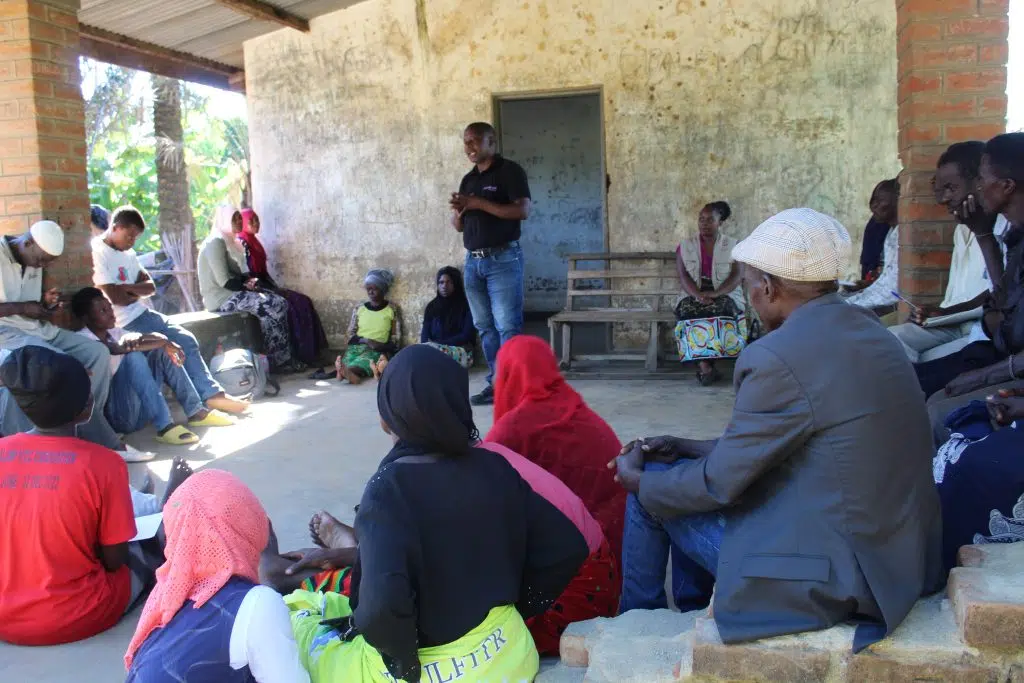Restoring Malawi’s iconic Chia Lagoon

Covering 17 square kilometers Chia, Malawi's largest lagoon supports diverse ecosystems.
By Temwanani Kalulu
Meet Ali Maulidi, the 30-year-old chairperson of the Chimpini Bird Hunting Club in Chimpini Village, Nkhotakota District, Southern Malawi. Since 2017, Ali has been hunting birds for food and sale around Chia Lagoon. Located approximately 24 kilometers south of Nkhotakota town in Central Malawi, Chia Lagoon is the largest lagoon in Malawi. The lagoon covers an impressive 17 square kilometers in the middle of a watershed that stretches across approximately 989 square kilometers.
Chia Lagoon supports diverse ecosystems and is home to various species, including Banded Tilapia (Tilapia sparrmanii), and a wide variety of bird species such as Ring-necked Dove (Streptopelia capicola), Lesser Masked Weaver (Ploceus intermedius), Black Heron (Egretta ardesiaca), as well as marsh reeds and shrubs. Further, it supports the livelihoods of more than 7,857 households, including farmers, fishermen, and bird hunters.
“Hunting has been the main economic activity for us. In a good month, we earn about Malawian Kwacha MK100,000 (US$57) from bird hunting. We use this money to purchase food, agricultural inputs, and pay for school fees for our children”, says Ali.
Over the years, Ali and many others have observed a gradual decline in bird populations at Chia, significantly affecting their livelihoods.
“Chia Lagoon had plenty of birds that made our hunting very easy and quite enjoyable, but the catches have fallen dramatically with each hunting trip. It is really frustrating because the sales we make from the little catch we get are not adequate to cover our needs. To make matters worse, most bird hunters have no other skills apart from bird hunting, so this is the only way they know how to make money and fend for their families. In my case, I have to travel far distances just to sell the few birds I catch to make ends meet,” he adds.
In addition to unsustainable hunting practices, other factors such as habitat destruction and climate change have contributed to this decline.

In 2023, BirdLife International’s partner in Malawi, the Wildlife and Environmental Society of Malawi (WESM), in collaboration with Malawi University of Science and Technology (MUST) and the Micro Loan Foundation, began implementing the “Community Approach to Waterbird Resources Management at Chia Lagoon” project. This three-year project, funded by the UK government through Darwin Initiative, aims to restore the vital Chia Lagoon ecosystem, reverse declines in vulnerable bird species, and improve local livelihoods. As part of the project implementation activities, WESM has established community-based sustainable hunting groups to better conserve waterbirds through the establishment of bird sanctuaries and habitat restoration activities.
“The project will work with communities to better manage and restore the vital lagoon ecosystem, reverse the decline in vulnerable and declining bird species, and improve livelihoods in the communities. Provision of biodiversity data for monitoring and the site’s assessment as a Key Biodiversity Area, form key components of the project. Supplemental, sustainable livelihood opportunities will be supported through a micro-lending institution”, says Blessing Chingagwe, WESM Programs Manager.
Chimpini Hunting Club is working with WESM to implement sustainable bird hunting management, avitourism, monitor and document bird populations, as well as establish bird hunting protocols. As part of these effort, bird hunting club representatives and traditional leaders participated in an exchange visit to Lake Chilwa in southern Malawi, which focused on key areas including hunting management, bird census, and record-keeping and management.
“With the capacity building for enterprise support among the community living around the lagoon, exposure to Chilwa for benchmarking on responsible bird hunting, new information and knowledge generated from ecological assessments, establishment of bird sanctuaries, support for restoration activities among other project interventions, the community will take up it’s rightful central place in sustainably managing Chia resources”, adds Alex Ngari, the project leader and BirdLife Africa’s Flyways Programme Manager.
In March 2023, the project facilitated the first bird guiding training, with 180 hunters trained on how to identify and record bird species as part of capacity building in avitourism. Additionally, the project procured, distributed, and supervised the planting of 6,000 tree seedlings as part of restoration activities of degraded areas around Chia Lagoon, covering 8.1 hectares. Two village Natural Resources Management Committees and eight Bird Hunting Clubs from 10 villages around the lagoon participated in the exercise.
“Participating in the project activities has been truly life changing for me and my fellow bird hunters.Through our collaboration and meaningful engagement with WESM in this project, we have gained invaluable knowledge in hunting management, environmental conservation, tour guiding, and business management. This has inspired me to utilize the natural resources around Chia Lagoon responsibly,” Ali notes.
As part of project implementation activities, a bird sanctuary mapping exercise was conducted in February 2024 in collaboration with the Malawi University of Science and Technology (MUST) and the Fisheries Department. Following the exercise, 15 bird sanctuaries were mapped out within the lagoon.
The exercise not only provided invaluable data for conservation planning but also empowered local communities to take an active role in safeguarding their natural heritage through involvement in the mapping exercise. Further, it facilitates education for local communities about their natural environment and built capacity for members through skill development in mapping techniques and data collection, in addition to fostering a sense of ownership and collective responsibility towards the protection of waterbird habitats.

Improving Livelihoods
Supporting and promoting sustainable livelihood is a key aspect of the project. This is being implemented through supporting enterprises, establishing a microfinance facility supported by the Micro Loan Foundation for 150 beneficiaries – 90% of whom are women, training in financial management and business in addition to promoting avitourism opportunities through materials and outreach to wildlife tourism enterprises.
Through a participatory process with community members, viable sustainable enterprises were identified including fish business, irrigated rice farming, beekeeping, and avitourism/ecotourism. In March 2024, the project organized a two -day training focusing on business management, bird identification, and recording as part of the enterprise and avitourism support.
A total of 180 participants attended the training, including 79 women and 101 men from all the hunting clubs around Chia Lagoon.
“This training has been a great eye-opener for us because up until now we just hunted and sold birds without any knowledge of business management. In my case, I did not even know that I could start an ecotourism business and guide tourists who visit Chia Lagoon for bird watching. This is life-changing for me. I am very excited to use the knowledge I have acquired”, said Alatiya Mponda, a participant from Bwanakaya Bird Hunting Club who attended the training.

Looking ahead, the project intends to achieve remarkable strides in 2024, including conducting an assessment of the Chia Lagoon against Key Biodiversity Areas (KBA)/Ramsar criteria, producing and distributing a bird ID guide to schools, WESM branches, and visitor lodges, providing comprehensive training and support for livelihoods to community members, and continuing restoration activities including the establishment of tree nurseries and removal of invasive alien species.
“By establishing and promoting livelihood opportunities through the engagement of bird hunters and other key stakeholders, as well as carrying out restoration activities, this project is holistically addressing the most pressing issues that affect Chia Lagoon’s biodiversity and surrounding communities”, concludes Chifundo Dalireni, WESM Project Coordinator.

Header photo: Part of the Chia lagoon pictured during the bird Sanctuary Mapping exercise © Gift Maluwa

“The project will work with communities to better manage and restore the vital lagoon ecosystem, reverse the decline in vulnerable and declining bird species, and improve livelihoods in the communities.”
Blessing Chingagwe, WESM Programs Manager